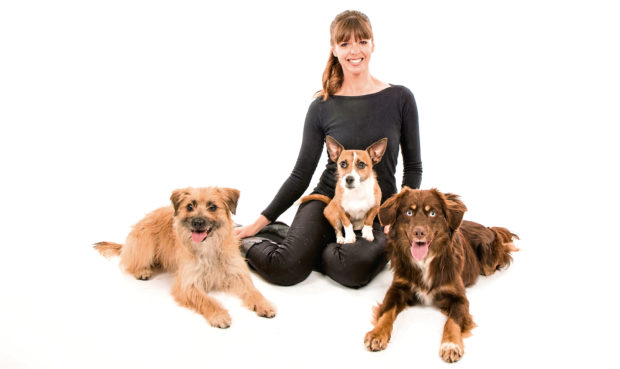
She’s known as the “dog decoder”, unlocking the minds of dogs worldwide and helping owners to understand and strengthen their bond with their four-legged friends.
Victoria Stilwell, the award-winning dog trainer and host of Channel 4’s hit TV series, It’s Me Or The Dog, has seen our pet pooches do some amazing things during the course of her career – from detecting a seizure 10 minutes before it happens, to flying a plane (really!).
The former actress – who was born in London but now lives in Atlanta, Georgia, with her husband, their daughter and two dogs, a Chihuahua mix called Jasmine and a 12-year-old Shih Tsu mix called Bella – now has a new book out, called The Secret Language Of Dogs: Unlocking The Canine Mind For A Happier Pet.
As the title suggests, it offers a range of pooch pointers, such as what you can tell about your dog through their body language and actions.
Here, Victoria unveils some of our beloved dogs’ behaviours and the psychology behind them…
What do different tail wags mean?
It depends on the breed of dog, the environment and what the rest of its body is doing, says Victoria.
A resting beagle might hold her tail relatively high, whereas a whippet’s natural tail position is low and curved. And tail-wagging doesn’t always denote a happy, excited dog.
“Dogs will wag their tails when they are uncomfortable, or aroused because something is worrying or exciting them. Dogs defending territory or being defensive can wag their tails very fast.”
Generally though, a dog which holds her tail in the air is a confident dog, happy to advertise her presence.
When a dog wags its tail around like a helicopter, with a relaxed movement and a wiggling bottom, it’s signalling a willingness to engage. Also, studies have shown that dogs wag their tail more to the right when greeting people they know and like, but wag more to the left when seeing an unfamiliar dog.
What does being left-pawed say about my dog’s personality?
Just like humans, some dogs naturally begin playing with a toy with their right paw, others with their left.
Right-pawed dogs can cope better with novel environments and situations, whereas left-pawed dogs show more stranger-directed aggression than right-pawed or ambilateral dogs, studies have suggested.
Other studies have shown that dogs with no paw preference may be more reactive to loud noises, while dogs with a strong paw preference are more confident and playful and less anxious than dogs with weaker paw preferences.
Do dogs feel empathy?
“They can, but not in the way we would hope that they would,” says Victoria.
“On a TV series I worked on called Dogs Might Fly, we taught dogs to fly a plane.
“We picked 12 rescue dogs and took them to a manor house in the south of England and tested their cognitive processes for 10 weeks.
“As part of finding out about how they feel and think, one of the tests we did was empathy.
“Even though we can say our dogs sympathise with us because they show consolation behaviour – for example, if we’re feeling sad they might come over and put their head in our lap – that’s not empathy.
“But empathy is also about being emotionally in tune with somebody. Dogs are empathetic in that kind of way.”
Do dogs feel guilt?
“Right now, we don’t think dogs have that complex, cognitive ability to feel guilty. However, I’m sure more research needs to be done on that subject.”
Do dogs get jealous?
“Oh yes. Jealousy is very close to anger. It’s the loss of perceived undivided attention and the fear of losing something valuable.
“Our dogs are big resource-guarders. They guard toys and food and areas and space. If two people hug, they can barge right in-between because they have lost attention.
“It’s very similar with humans. We guard our resources just as much as dogs. Dogs are doing exactly the same.”
Do dogs feel grief?
“Without a doubt. I lost my chocolate Labrador last February. My Chihuahua used to lie on the Labrador to go to sleep. The Labrador was her anchor and when the dog died, the Chihuahua grieved – she became very clingy with us, and whined. There have been stories of dogs who’ve gone into depression, taking themselves off, not wanting to interact, or becoming more needy, which also happens when they lose people.”
What can you tell about a dog’s bark?
If your dog has been left home alone for any length of time, he or she may bark just to pass the time.
“If your dog is a boredom barker, it’s essential you make her day more enriching, hiring a dog walker or taking her to doggy day care,” says Victoria.
Dogs bark with excitement just as humans vocalise in exciting situations, while dogs who are anxious about being alone, separated from their humans, will often bark to try to re-establish contact and soothe themselves.
Lonely barking is usually a series of barks followed by long pauses, as the dog waits to see if her calls have been answered.
As Victoria explains: “Barking serves a very important function, allowing the dog to communicate its emotional state, or a warning, or that it doesn’t feel well, or to alert you.”
The Secret Language Of Dogs: Unlocking The Canine Mind For A Happier Pet by Victoria Stilwell is published by Hamlyn, priced £12.99. Available now.

Enjoy the convenience of having The Sunday Post delivered as a digital ePaper straight to your smartphone, tablet or computer.
Subscribe for only £5.49 a month and enjoy all the benefits of the printed paper as a digital replica.
Subscribe